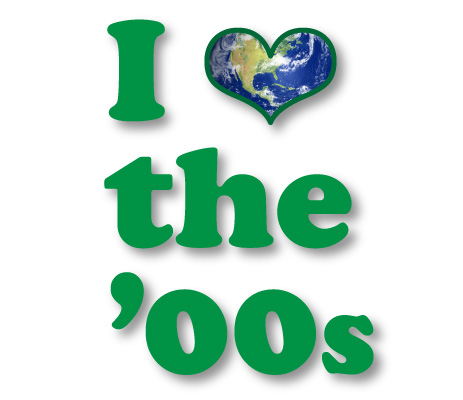POP ‘TIL YOU DROP
Celebs and movies and magazines and TV go green

Everyone who’s anyone made a show of going green during the ‘00s — sometimes literally. Cameron Diaz had her Trippin’ series on MTV, kicking off a trend later embraced by stars like Brad Pitt and Adrian Grenier. Leonardo DiCaprio whipped up both a TV show and a documentary, the Discovery Channel launched Planet Green TV, and NBC declared that “Green Is Universal.” Countless other celebs “went green” in their own little (sometimes very little) ways. The media jumped all over this trend, with Julia Roberts and George Clooney joining  Al Gore and RFK Jr. on the cover of Vanity Fair‘s first green issue in 2006. Then other glossy mags like Glamour, Outside, and Sports Illustrated hopped on the green-issue bandwagon. Elsewhere in pop culture, The Day After Tomorrow turned climate chaos into a big-screen blockbuster. Musicians from Madonna to Miley crooned about the climate, and Live Earth made a spectacle of eco-music. Fashion, design, TV, art–they all embraced the environment. But when Paris Hilton sported a “think green” T-shirt, this cause celeb officially became a cause parodique.
Al Gore and RFK Jr. on the cover of Vanity Fair‘s first green issue in 2006. Then other glossy mags like Glamour, Outside, and Sports Illustrated hopped on the green-issue bandwagon. Elsewhere in pop culture, The Day After Tomorrow turned climate chaos into a big-screen blockbuster. Musicians from Madonna to Miley crooned about the climate, and Live Earth made a spectacle of eco-music. Fashion, design, TV, art–they all embraced the environment. But when Paris Hilton sported a “think green” T-shirt, this cause celeb officially became a cause parodique.
BABY BOTTLE BLUES
The backlash against BPA and other toxic nasties
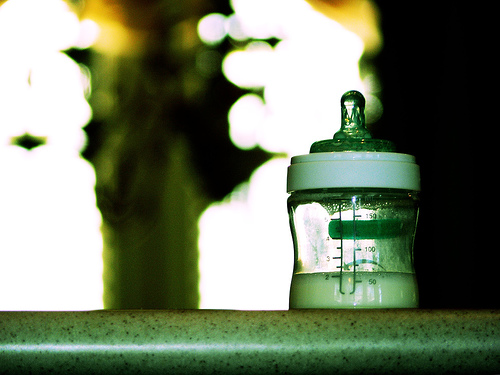 Photo: Maury McCownFor 40 years, environmentalists worried about a cocktail of scary but familiar toxic acronyms like DDT and PCBs. In the ’00s, we got a raft of new body-invaders to fret about, including PVC, PBDEs, and the real headline-grabber, BPA. Parents in particular got their hackles up when news emerged that the plastic hardener bisphenol A, an endocrine disrupter, is used in products including baby bottles, infant formula cans, and pacifiers. Panic ensued, and some manufacturers and retailers, including Toys”R”Us, Wal-Mart, and Nalgene, began pushing BPA-free products. While states and municipalities rushed to introduce legislation banning the stuff, U.S. regulators struggled with how to manage it, initially relying on an industry-weighted panel that said BPA was A-OK. In fall of 2009, EPA Administrator Lisa Jackson said the agency would tighten up the nation’s flimsy 1970s-era toxics law, and crack down in the meantime on BPA and five other red-flag substances. And not a moment too soon: a recent study found 232 chemicals in umbilical-cord blood. Turns out the gift of life comes with toxic strings attached.
Photo: Maury McCownFor 40 years, environmentalists worried about a cocktail of scary but familiar toxic acronyms like DDT and PCBs. In the ’00s, we got a raft of new body-invaders to fret about, including PVC, PBDEs, and the real headline-grabber, BPA. Parents in particular got their hackles up when news emerged that the plastic hardener bisphenol A, an endocrine disrupter, is used in products including baby bottles, infant formula cans, and pacifiers. Panic ensued, and some manufacturers and retailers, including Toys”R”Us, Wal-Mart, and Nalgene, began pushing BPA-free products. While states and municipalities rushed to introduce legislation banning the stuff, U.S. regulators struggled with how to manage it, initially relying on an industry-weighted panel that said BPA was A-OK. In fall of 2009, EPA Administrator Lisa Jackson said the agency would tighten up the nation’s flimsy 1970s-era toxics law, and crack down in the meantime on BPA and five other red-flag substances. And not a moment too soon: a recent study found 232 chemicals in umbilical-cord blood. Turns out the gift of life comes with toxic strings attached.
FORGET SNAIL DARTERS
Climate takes over the environmental movement
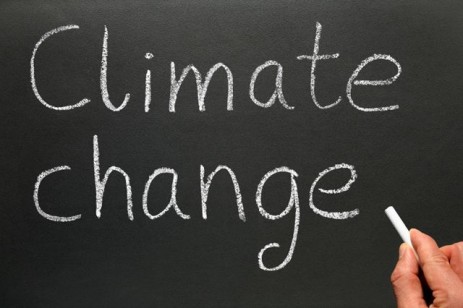 In the year 2000, the hot environmental issues in the U.S. were logging in Alaska’s Tongass National Forest and other roadless areas, salmon-impeding dams on the Lower Snake River in the Northwest, genetically modified foods, the WTO’s impacts on environmental regulation, and, oh yeah, that climate problem. A decade later, it seems like it’s all climate, all the time — thanks in no small part to a certain ex-vice president (more on him below). The big green groups are pouring most of their efforts into climate and energy issues. Smaller activist groups that have traditionally focused on wilderness, endangered species, rivers, you name it, have scrambled to recast their efforts with an explicit global-warming link. New grassroots groups have sprung up solely for the purpose of battling this crisis. And internet-driven campaigns like Step It Up and 350.org have converted millions of people around the world into climate activists, if just for a few hours. On the plus side, it’s an amazing concentration of energy dedicated to solving a ginormous problem. On the minus, it’s nudged a lot of other issues out of the spotlight, from water pollution to GMOs to toxic air emissions.
In the year 2000, the hot environmental issues in the U.S. were logging in Alaska’s Tongass National Forest and other roadless areas, salmon-impeding dams on the Lower Snake River in the Northwest, genetically modified foods, the WTO’s impacts on environmental regulation, and, oh yeah, that climate problem. A decade later, it seems like it’s all climate, all the time — thanks in no small part to a certain ex-vice president (more on him below). The big green groups are pouring most of their efforts into climate and energy issues. Smaller activist groups that have traditionally focused on wilderness, endangered species, rivers, you name it, have scrambled to recast their efforts with an explicit global-warming link. New grassroots groups have sprung up solely for the purpose of battling this crisis. And internet-driven campaigns like Step It Up and 350.org have converted millions of people around the world into climate activists, if just for a few hours. On the plus side, it’s an amazing concentration of energy dedicated to solving a ginormous problem. On the minus, it’s nudged a lot of other issues out of the spotlight, from water pollution to GMOs to toxic air emissions.
IT’S NOT JUST FOR TREEHUGGERS ANYMORE
The green tent gets bigger
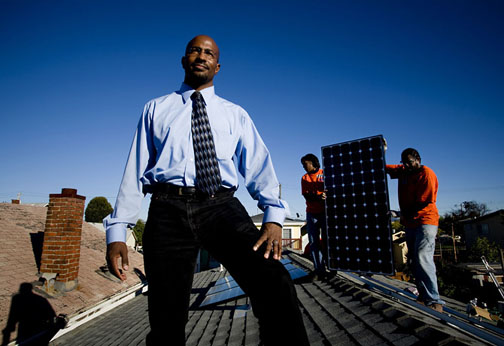 Van Jones and solar installersNot so long ago, the word “environmentalist” conjured upper-middle-class white people fixated on endangered critters and far-off wildlands. Oh, fine, it still does for a lot of people. But in the past decade, the movement has exploded well beyond that stereotype. Van Jones and Majora Carter spread the message that smart energy policy can mean jobs in inner cities. Labor unions and green groups teamed up to create the Blue Green Alliance. Religious folks, including conservative evangelicals, began talking about “creation care” and other faith-inspired approaches to conservation. Republicans including California Gov. Arnold Schwarzenegger and Florida Gov. Charlie Crist adopted ambitious plans to address climate change. Hunters and anglers tuned in, worried about global warming ruining their outdoor adventures. National-security hawks — aka “geo-greens” — want to wean the U.S. off foreign oil. Wonky bloggers who rarely see the light of day, let alone a hiking trail, are delving into the nuances of clean-energy policy. Perhaps the most impassioned new group is da yoots–college students and other young people who are really riled up about climate change. The environmental movement could still use a lot more diversity, but it’s not just for Prescott P. Treehugger III any more (and it’s definitely not dead).
Van Jones and solar installersNot so long ago, the word “environmentalist” conjured upper-middle-class white people fixated on endangered critters and far-off wildlands. Oh, fine, it still does for a lot of people. But in the past decade, the movement has exploded well beyond that stereotype. Van Jones and Majora Carter spread the message that smart energy policy can mean jobs in inner cities. Labor unions and green groups teamed up to create the Blue Green Alliance. Religious folks, including conservative evangelicals, began talking about “creation care” and other faith-inspired approaches to conservation. Republicans including California Gov. Arnold Schwarzenegger and Florida Gov. Charlie Crist adopted ambitious plans to address climate change. Hunters and anglers tuned in, worried about global warming ruining their outdoor adventures. National-security hawks — aka “geo-greens” — want to wean the U.S. off foreign oil. Wonky bloggers who rarely see the light of day, let alone a hiking trail, are delving into the nuances of clean-energy policy. Perhaps the most impassioned new group is da yoots–college students and other young people who are really riled up about climate change. The environmental movement could still use a lot more diversity, but it’s not just for Prescott P. Treehugger III any more (and it’s definitely not dead).
YADDA YADDA YADDA
U.S. politicians talk about climate change
 While U.S. politicians blithely ignored the environment for most of the last decade (and the last century), the 2008 election marked a visible turning point — in rhetoric, at least. John Edwards got things rolling by adopting a goal of reducing U.S. greenhouse-gas emissions 80 percent by 2050; his Democratic competitors, Hillary Clinton and Barack Obama, saw his target and raised him 100 percent auctioned pollution allowances. On the Republican side, the most climate-concerned candidate won the primary, and though John McCain didn’t offer up a particularly aggressive (or internally consistent) climate plan, he never backed down from saying climate change was a real problem. Many Democratic Senate candidates put climate action in their platforms. Meanwhile, on the local level, more than 1,000 mayors — Republicans and Democrats — pledged to reduce their cities’ greenhouse-gas emissions. A number of governors put climate plans in place too. Turning all that talk into real action? That’s been put off until the next decade.
While U.S. politicians blithely ignored the environment for most of the last decade (and the last century), the 2008 election marked a visible turning point — in rhetoric, at least. John Edwards got things rolling by adopting a goal of reducing U.S. greenhouse-gas emissions 80 percent by 2050; his Democratic competitors, Hillary Clinton and Barack Obama, saw his target and raised him 100 percent auctioned pollution allowances. On the Republican side, the most climate-concerned candidate won the primary, and though John McCain didn’t offer up a particularly aggressive (or internally consistent) climate plan, he never backed down from saying climate change was a real problem. Many Democratic Senate candidates put climate action in their platforms. Meanwhile, on the local level, more than 1,000 mayors — Republicans and Democrats — pledged to reduce their cities’ greenhouse-gas emissions. A number of governors put climate plans in place too. Turning all that talk into real action? That’s been put off until the next decade.
LOCAL GETS VOCAL, ORGANIC GOES MANIC
The sustainable food movement comes into its own
 Photo: Natalie MaynorA decade ago, food was a necessary evil that environmentalists scarfed down as they biked to the next anti-whaling rally. But that changed in the ’00s. The publication in 2001 of Eric Schlosser’s Fast Food Nation brought food-related issues onto the progressive radar screen by shining a light on the brutal social conditions that underpin our current system. The election of George W. Bush and its attendant hopelessness pushed greens to focus inward on things they could actually change, like their underwear and their diets. And then in 2005, Michael Pollan’s Omnivore’s Dilemma offered a feast of reasons to rebuild local and regional food systems. Progressives nationwide flocked to farmers’ markets, joined CSAs, gobbled up organics, and launched farms and community gardens. Meanwhile, the effort to bring fresh, wholesome food to low-income urban areas grew into a movement known as “food justice.” As the role of agricultural production in climate change becomes ever clearer, food is claiming its rightful place at the green table, with no expiration date in sight.
Photo: Natalie MaynorA decade ago, food was a necessary evil that environmentalists scarfed down as they biked to the next anti-whaling rally. But that changed in the ’00s. The publication in 2001 of Eric Schlosser’s Fast Food Nation brought food-related issues onto the progressive radar screen by shining a light on the brutal social conditions that underpin our current system. The election of George W. Bush and its attendant hopelessness pushed greens to focus inward on things they could actually change, like their underwear and their diets. And then in 2005, Michael Pollan’s Omnivore’s Dilemma offered a feast of reasons to rebuild local and regional food systems. Progressives nationwide flocked to farmers’ markets, joined CSAs, gobbled up organics, and launched farms and community gardens. Meanwhile, the effort to bring fresh, wholesome food to low-income urban areas grew into a movement known as “food justice.” As the role of agricultural production in climate change becomes ever clearer, food is claiming its rightful place at the green table, with no expiration date in sight.
OH SAY CAN YOU CEO
Biz wakes up to green
 “Green business” used to mean niche enterprises selling hemp sandals and do-it-yourself solar arrays. But in the ’00s, green biz went big and broad. Wal-Mart, GE, Clorox, Dell, and lots of other corporate giants got in the game, recognizing that they could burnish their reps, cut overhead, and actually — gasp! — make money by adopting greener products and practices. Nike, Johnson & Johnson, Apple, and others called for climate action and distanced themselves from climate-denying groups like the U.S. Chamber of Commerce. Even energy companies like Duke and BP started at least giving lip service to clean power and climate mitigation. In Silicon Valley, all the cool kids turned to green, from the Google guys to Paypal founder Elon Musk. And the funding — mmm, can you smell it? In 2001, venture-capital investment in cleantech in North America, Europe, Israel, China, and India totaled $507 million; by 2008, it hit $8.4 billion. Countless eco-products appeared for an increasingly eco-enraptured public, from the truly useful to the utterly abusrd. Now the sour economy has dampened some companies’ green efforts — and some of those efforts were window-dressing to begin with. But after the ’00s, no one can say that environmentalism is anti-business, or vice versa.
“Green business” used to mean niche enterprises selling hemp sandals and do-it-yourself solar arrays. But in the ’00s, green biz went big and broad. Wal-Mart, GE, Clorox, Dell, and lots of other corporate giants got in the game, recognizing that they could burnish their reps, cut overhead, and actually — gasp! — make money by adopting greener products and practices. Nike, Johnson & Johnson, Apple, and others called for climate action and distanced themselves from climate-denying groups like the U.S. Chamber of Commerce. Even energy companies like Duke and BP started at least giving lip service to clean power and climate mitigation. In Silicon Valley, all the cool kids turned to green, from the Google guys to Paypal founder Elon Musk. And the funding — mmm, can you smell it? In 2001, venture-capital investment in cleantech in North America, Europe, Israel, China, and India totaled $507 million; by 2008, it hit $8.4 billion. Countless eco-products appeared for an increasingly eco-enraptured public, from the truly useful to the utterly abusrd. Now the sour economy has dampened some companies’ green efforts — and some of those efforts were window-dressing to begin with. But after the ’00s, no one can say that environmentalism is anti-business, or vice versa.
ATTENTION MUST BE PAID!
Climate scientists panic; public yawns
 In 2001, the Intergovernmental Panel on Climate Change released its comprehensive, multi-peer-reviewed Third Assessment Report on the state of climate science, warning of “new and stronger evidence” that human activity is driving destabilizing changes in the climate. By its fourth report in 2007, the IPCC called the basic conclusion of anthropogenic climate change “very” (i.e., more than 90 percent) likely. In late November 2009, on the eve of the Copenhagen climate talks, a group of 26 climatologists released a “Copenhagen Diagnosis” updating the IPCC report with the latest science. Every advance in climate science over the last decade has revealed that things are getting worse, faster, than most climate models predicted. The so-called Climategate scandal in late 2009 embarrassed a few climate scientists, but did nothing to undermine the overwhelming scientific consensus that climate change is a big f***ing deal. Yet alongside this steadily more dire news, which has scientists on the edge of panic, public opinion has barely shifted. There was a hubbub over a small drop in climate concern last month, but a change from “eh” to “ehh” is hardly news.
In 2001, the Intergovernmental Panel on Climate Change released its comprehensive, multi-peer-reviewed Third Assessment Report on the state of climate science, warning of “new and stronger evidence” that human activity is driving destabilizing changes in the climate. By its fourth report in 2007, the IPCC called the basic conclusion of anthropogenic climate change “very” (i.e., more than 90 percent) likely. In late November 2009, on the eve of the Copenhagen climate talks, a group of 26 climatologists released a “Copenhagen Diagnosis” updating the IPCC report with the latest science. Every advance in climate science over the last decade has revealed that things are getting worse, faster, than most climate models predicted. The so-called Climategate scandal in late 2009 embarrassed a few climate scientists, but did nothing to undermine the overwhelming scientific consensus that climate change is a big f***ing deal. Yet alongside this steadily more dire news, which has scientists on the edge of panic, public opinion has barely shifted. There was a hubbub over a small drop in climate concern last month, but a change from “eh” to “ehh” is hardly news.
SPINNING INTO SPUTTER
Climate treaties tank
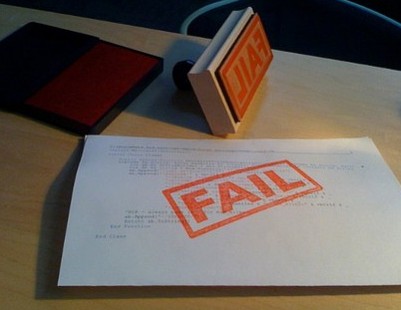 Photo: Hans GerwitzThe Kyoto Protocol officially kicked into gear in 2005–no thanks to the U.S. In the half-decade since, greenhouse-gas emissions have kept on soaring. Hopes were high for the Copenhagen Climate Conference to produce an agreement that might really get the job done. Hmm, that didn’t pan out either. All in all, the ’00s were not a good decade for global climate treaties.
Photo: Hans GerwitzThe Kyoto Protocol officially kicked into gear in 2005–no thanks to the U.S. In the half-decade since, greenhouse-gas emissions have kept on soaring. Hopes were high for the Copenhagen Climate Conference to produce an agreement that might really get the job done. Hmm, that didn’t pan out either. All in all, the ’00s were not a good decade for global climate treaties.
KA-CHING
Saving the world makes cents
 Environmentalism entered the ’00s with a reputation for being anti-jobs and anti-growth, but it’s leaving the decade waving its pro-prosperity flag high. “Green jobs” has gone from back-room rallying cry to presidential campaign promise to $5 billion federal investment, and said jobs are materializing across the U.S., from California cleantech to Michigan motors to Delaware ductwork. It’s all part of an effort to jump-start the economy and attack climate change in one fell swoop — a feat that industry-funded think tanks and other skeptics have long said is impossible. But many smartypants economists now contend that a healthier climate means a healthier economy. When the Stern Review on the Economics of Climate Change came out in 2006 arguing that cost-benefit analysis favors ambitious climate action, it sparked raging debate. Since then, the basic conclusion that climate action makes financial sense has been confirmed by similar studies from the International Energy Agency, the U.S. EPA, and the Congressional Budget Office. See, the enviros like forward progress! But seriously, don’t touch the wetlands.
Environmentalism entered the ’00s with a reputation for being anti-jobs and anti-growth, but it’s leaving the decade waving its pro-prosperity flag high. “Green jobs” has gone from back-room rallying cry to presidential campaign promise to $5 billion federal investment, and said jobs are materializing across the U.S., from California cleantech to Michigan motors to Delaware ductwork. It’s all part of an effort to jump-start the economy and attack climate change in one fell swoop — a feat that industry-funded think tanks and other skeptics have long said is impossible. But many smartypants economists now contend that a healthier climate means a healthier economy. When the Stern Review on the Economics of Climate Change came out in 2006 arguing that cost-benefit analysis favors ambitious climate action, it sparked raging debate. Since then, the basic conclusion that climate action makes financial sense has been confirmed by similar studies from the International Energy Agency, the U.S. EPA, and the Congressional Budget Office. See, the enviros like forward progress! But seriously, don’t touch the wetlands.
STRAIGHT OUTTA GNASHVILLE
Al Gore’s excellent adventure
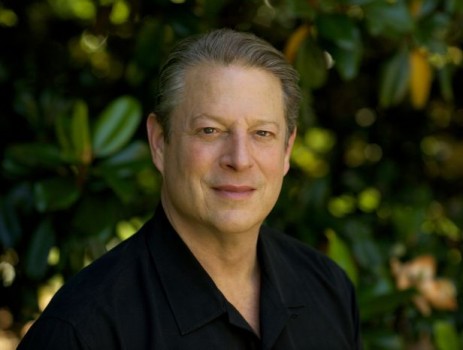 Love him or hate him — and apparently it’s one of the two — it’s hard to think of a more remarkable personal story this decade than the saga of Al Gore. After “losing” the 2000 election, he was distraught, shunned by the Democrats he’d led and the public that had given him a majority of the popular vote. After a short, bearded, self-imposed exile, he made a simple decision: if climate change is the greatest danger to humanity, something he’d been discouraged from saying for most of his electoral career, then he would say so. He set about spreading the word in characteristic nerdy, earnest fashion, with a slide show, a patient explanation, and four gazillion frequent flier miles. And he kept going until he ran across people who could help him spread the message further, and further, and lo and behold: people heard. An Emmy, an Oscar, a Nobel Prize. Incredible, really. Gore does not have Obama’s comfort in his own skin or Bill Clinton’s disarming charm. His is the story of a man who knows his own limitations — has had them crammed in his face repeatedly — but never stops seeking to overcome them. His success is a tribute to moral concern and sheer, cussed dedication.
Love him or hate him — and apparently it’s one of the two — it’s hard to think of a more remarkable personal story this decade than the saga of Al Gore. After “losing” the 2000 election, he was distraught, shunned by the Democrats he’d led and the public that had given him a majority of the popular vote. After a short, bearded, self-imposed exile, he made a simple decision: if climate change is the greatest danger to humanity, something he’d been discouraged from saying for most of his electoral career, then he would say so. He set about spreading the word in characteristic nerdy, earnest fashion, with a slide show, a patient explanation, and four gazillion frequent flier miles. And he kept going until he ran across people who could help him spread the message further, and further, and lo and behold: people heard. An Emmy, an Oscar, a Nobel Prize. Incredible, really. Gore does not have Obama’s comfort in his own skin or Bill Clinton’s disarming charm. His is the story of a man who knows his own limitations — has had them crammed in his face repeatedly — but never stops seeking to overcome them. His success is a tribute to moral concern and sheer, cussed dedication.
REMEMBER THE TITANS
China and India take the helm
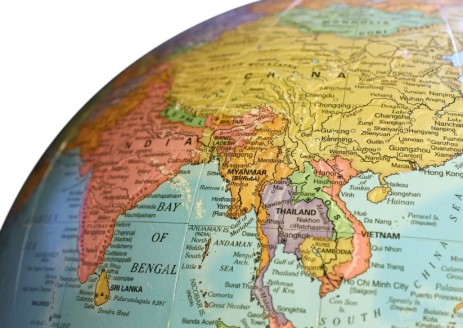 As the world fretted over its sweaty fate this decade, it suddenly realized there were two sleeping giants huddled in the corner of the sauna: China and India. With billions of people calling these countries home and globalization converting them first into gewgaw-makers and support call-takers, then into tech giants, their appetite for energy is ravenous. Fueled largely by coal and unthwartable ambition, China overtook the U.S. as the world’s largest emitter of greenhouse gases (though it’s not quite that simple), while India rose to the No. 4 spot. At the same time, China is giving the U.S. a serious run for its money in the cleantech sector, with its formidable and fast-growing wind and solar industries, and India is getting into the game as well. At the Copenhagen climate talks in December 2009, China, more than any other nation, was the big impediment to a meaningful global agreement — and yet any agreement that doesn’t include China simply won’t get the job done. Whether the task at hand is polluting the planet or saving it, China and (to a lesser extent) India are now calling the shots.
As the world fretted over its sweaty fate this decade, it suddenly realized there were two sleeping giants huddled in the corner of the sauna: China and India. With billions of people calling these countries home and globalization converting them first into gewgaw-makers and support call-takers, then into tech giants, their appetite for energy is ravenous. Fueled largely by coal and unthwartable ambition, China overtook the U.S. as the world’s largest emitter of greenhouse gases (though it’s not quite that simple), while India rose to the No. 4 spot. At the same time, China is giving the U.S. a serious run for its money in the cleantech sector, with its formidable and fast-growing wind and solar industries, and India is getting into the game as well. At the Copenhagen climate talks in December 2009, China, more than any other nation, was the big impediment to a meaningful global agreement — and yet any agreement that doesn’t include China simply won’t get the job done. Whether the task at hand is polluting the planet or saving it, China and (to a lesser extent) India are now calling the shots.
TRICK OR TREATY
Bush pulls out of Kyoto
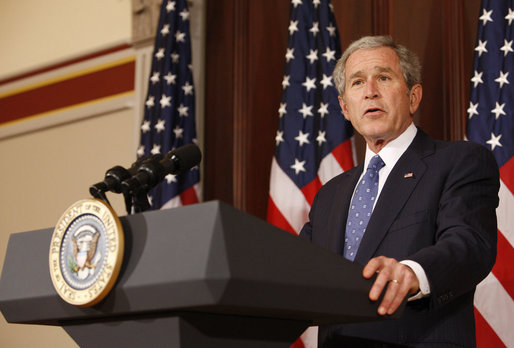 Photo: White House/Chris GreenbergDuring the 2000 presidential campaign, George W. Bush neutralized Al Gore’s pledge to restrict planet-warming carbon dioxide emissions by promising to do the same himself. It may go down as one of history’s more fateful lies. After “winning” the election, Bush promptly reneged on his promise. In March 2001, Bush went one better and, without even telling his EPA administrator, Christine Todd Whitman, declared that the U.S. would not ratify the Kyoto Protocol. There followed eight long years of mulish, intractable stalling from the U.S. on climate change. The world community’s pleas for leadership were spurned and precious time was frittered away. Now the level of effort needed to reduce emissions in time to avert catastrophe is steeper, the political problem thornier. Damn you, butterfly ballots!
Photo: White House/Chris GreenbergDuring the 2000 presidential campaign, George W. Bush neutralized Al Gore’s pledge to restrict planet-warming carbon dioxide emissions by promising to do the same himself. It may go down as one of history’s more fateful lies. After “winning” the election, Bush promptly reneged on his promise. In March 2001, Bush went one better and, without even telling his EPA administrator, Christine Todd Whitman, declared that the U.S. would not ratify the Kyoto Protocol. There followed eight long years of mulish, intractable stalling from the U.S. on climate change. The world community’s pleas for leadership were spurned and precious time was frittered away. Now the level of effort needed to reduce emissions in time to avert catastrophe is steeper, the political problem thornier. Damn you, butterfly ballots!
FRIENDS IN HIGH PLACES
Obama gets elected, pushes green initiatives
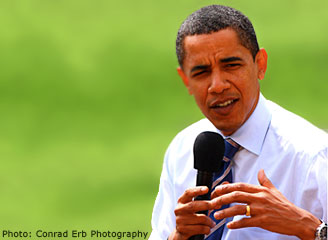 After eight years of soul-withering “leadership” by George W. Bush, progressives rejoiced at the election of Barack Obama in 2008. He appointed the greenest Cabinet ever, chock-full of top-notch scientists and long-time climate advocates. His administration has made massive green stimulus investments, set EPA moving forward to regulate CO2, pushed green jobs, promoted eco-friendly retrofits, established new fuel-economy rules and efficiency standards, launched national retrofit programs, delayed mining and drilling permits, set new energy standards and goals for all federal departments, created a White House garden and farmers market, and oh so much more. He hasn’t put a definite end to mountaintop-removal mining. He hasn’t stopped Big Ag in its tracks. Most gallingly, he hasn’t convinced the whole world (and the U.S. Senate) to sign on to an international climate treaty that will save the planet. But during less than a year in office, he’s definitely made his mark on the decade.
After eight years of soul-withering “leadership” by George W. Bush, progressives rejoiced at the election of Barack Obama in 2008. He appointed the greenest Cabinet ever, chock-full of top-notch scientists and long-time climate advocates. His administration has made massive green stimulus investments, set EPA moving forward to regulate CO2, pushed green jobs, promoted eco-friendly retrofits, established new fuel-economy rules and efficiency standards, launched national retrofit programs, delayed mining and drilling permits, set new energy standards and goals for all federal departments, created a White House garden and farmers market, and oh so much more. He hasn’t put a definite end to mountaintop-removal mining. He hasn’t stopped Big Ag in its tracks. Most gallingly, he hasn’t convinced the whole world (and the U.S. Senate) to sign on to an international climate treaty that will save the planet. But during less than a year in office, he’s definitely made his mark on the decade.
SLURRY WITH THE CRINGE ON TOP
The backlash against coal
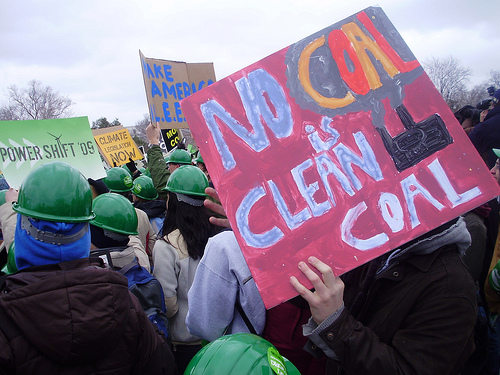 Photo: Focus the NationIn the last few years, the anti-coal movement has exploded faster than a West Virginia mountaintop, becoming the most exciting and effective story in the activist world. More than 100 coal plants have been stalled or killed since 2001. Climate-science godfather James Hansen and many others have gotten themselves arrested to make the point that climate change won’t stop until coal stops — period. And it’s not just coal’s climate-toasting impacts that are riling people up. The devastating practice of mountaintop-removal mining in Appalachia — wherein coal companies blast away entire peaks and destroy entire communities — has been pushed onto the mainstream political agenda, with Obama’s EPA at least scrutinizing it more closely and delaying permits. The appalling coal-ash spill of December 2008 got the whole country thinking about coal’s dirty underbelly. More and more people are angry about mercury pollution from coal plants, which can screw up brain development in kids. We like to think none of this would have happened if Grist’s own David Roberts hadn’t supplied the movement with a catchy slogan: “Coal is the enemy of the human race.” You’re welcome, future generations!
Photo: Focus the NationIn the last few years, the anti-coal movement has exploded faster than a West Virginia mountaintop, becoming the most exciting and effective story in the activist world. More than 100 coal plants have been stalled or killed since 2001. Climate-science godfather James Hansen and many others have gotten themselves arrested to make the point that climate change won’t stop until coal stops — period. And it’s not just coal’s climate-toasting impacts that are riling people up. The devastating practice of mountaintop-removal mining in Appalachia — wherein coal companies blast away entire peaks and destroy entire communities — has been pushed onto the mainstream political agenda, with Obama’s EPA at least scrutinizing it more closely and delaying permits. The appalling coal-ash spill of December 2008 got the whole country thinking about coal’s dirty underbelly. More and more people are angry about mercury pollution from coal plants, which can screw up brain development in kids. We like to think none of this would have happened if Grist’s own David Roberts hadn’t supplied the movement with a catchy slogan: “Coal is the enemy of the human race.” You’re welcome, future generations!
